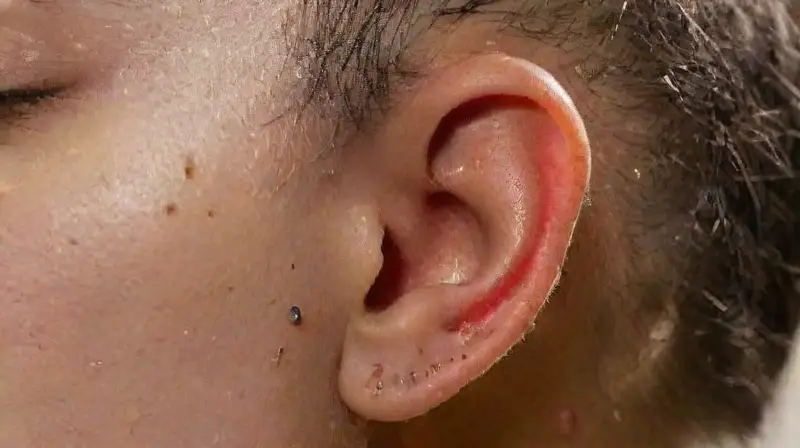Body piercings have become a popular form of self-expression across many cultures and communities worldwide. They offer an opportunity for individuals to showcase their style and personality through various adornments. However, despite their widespread acceptance, piercings can sometimes lead to skin reactions, which may cause discomfort and concern for the wearer.
These reactions can vary in severity and type, ranging from mild irritation to more serious allergic responses. Understanding the common skin issues related to piercings can help individuals take proper care and seek timely medical advice if needed. Awareness is key to minimizing potential complications associated with body modifications.
Inflammatory reactions
Inflammation is a common response that occurs shortly after getting a piercing. It often manifests as redness, swelling, and tenderness around the pierced area. This reaction can be caused by minor trauma during the piercing process or from exposure to irritants such as certain lotions or soaps.
In many cases, inflammation resolves on its own within a few days with proper hygiene and care. However, persistent or worsening inflammation might indicate an infection or allergic response that requires medical attention. Using sterile tools and following aftercare instructions are essential steps to prevent such issues.
In some instances, inflammation can develop into a more serious infection. Bacterial contamination during or after the piercing can lead to pus formation, increased pain, and swelling. Recognizing these signs early and consulting a healthcare professional can prevent complications and facilitate proper treatment.
Allergic reactions
Allergic reactions to body piercings are typically due to metal allergies, especially to nickel, which is a common component in many jewelry pieces. Symptoms often include itching, redness, and swelling that are localized around the pierced site.
Individuals with a history of metal allergies should opt for hypoallergenic materials such as surgical steel, titanium, or platinum. Choosing the right material can significantly reduce the risk of allergic contact dermatitis associated with piercings.
In cases of allergic reactions, removing or replacing the jewelry with a more suitable material usually alleviates symptoms. It’s important to consult a dermatologist if symptoms persist, as untreated allergies can lead to chronic skin issues and scarring.
Keloids and hypertrophic scars

Some people may develop keloids or hypertrophic scars following a piercing. These are overgrowths of scar tissue that can appear as raised, thickened, and sometimes itchy or tender skin. They are more common among individuals with a genetic predisposition for abnormal scarring.
The formation of keloids or hypertrophic scars can be triggered by trauma or irritation of the skin during the healing process. Proper aftercare, such as avoiding unnecessary touching or trauma to the piercing, can reduce the risk of abnormal scar formation.
Treatment options include various clinical interventions like steroid injections, silicone gels, or surgical removal. Prevention is key; therefore, choosing experienced professionals and following their aftercare advice can minimize scar-related skin reactions.
Infection risk
Infections are a significant concern with body piercings and can be caused by bacteria, fungi, or viruses. Poor hygiene, unsterile equipment, or contaminated jewelry are common sources of infection. Symptoms may include redness, warmth, pus, and increased pain at the pierced site.
Prompt medical treatment is crucial to prevent the spread of infection and potential complications. Antibiotics may be prescribed, and in severe cases, the piercing may need to be removed and the area thoroughly cleaned.
Preventive measures such as proper hygiene practices, avoiding touching the piercing with dirty hands, and ensuring all equipment is sterile can greatly reduce the risk of infection. Regular cleaning and monitoring during healing can promote a healthy recovery and minimize skin reactions.
Contact dermatitis
Contact dermatitis involves an inflammatory response of the skin caused by direct contact with irritating substances or allergens. In piercing procedures, exposure to certain cleaning agents, cosmetics, or irritant substances applied on the skin can trigger this reaction.
The symptoms include redness, itching, dryness, and sometimes blistering around the pierced area. Identifying and eliminating the offending agent is essential to resolve contact dermatitis effectively.
Using gentle, fragrance-free products and avoiding harsh chemicals near the piercing site can prevent irritation. If dermatitis occurs, topical corticosteroids and proper skin care can help soothe the skin and promote healing.
Skin infections and their management

Skin infections related to piercings can develop rapidly if proper aftercare isn’t followed. Bacterial infections are the most common, presenting with redness, swelling, warmth, and sometimes pus formation.
Management involves antiseptic cleaning of the affected area, possible antibiotic therapy, and sometimes removal of the jewelry if the infection is severe. Ignoring symptoms can lead to more serious issues such as cellulitis or abscess formation.
Prevention hinges on maintaining strict hygiene, avoiding contact with unclean objects, and adhering to the aftercare instructions provided by the professional. Educating oneself about early signs of infection can be vital for prompt intervention and skin health.
Scarring and long-term skin changes
Long-term skin changes following a piercing can include scarring, loss of sensation, or changes in skin pigmentation. Scars are an inevitable part of wound healing, but excessive or hypertrophic scarring can result from improper care or individual genetics.
Choosing experienced piercers and following aftercare advice can minimize permanent damage. Protecting the area from sun exposure during healing is also crucial to prevent pigmentary changes.
While some skin reactions are unavoidable, many skin-related issues can be managed effectively with appropriate treatment or by choosing suitable jewelry materials. Awareness and attentive care are the best strategies to ensure healthy skin after a piercing.
Conclusion
Skin reactions caused by body piercings are common and can range from mild irritation to severe infections or allergic responses. Being informed about potential issues allows individuals to take preventive measures and seek timely medical advice when needed.
Proper hygiene, choosing the right jewelry materials, and following professional aftercare instructions are essential steps to minimize adverse skin reactions. When complications occur, early intervention can prevent long-term damage and promote healthy healing.
Ultimately, understanding the risks and caring diligently for a new piercing can help ensure that the experience remains positive and safe, allowing for self-expression without compromising skin health.







